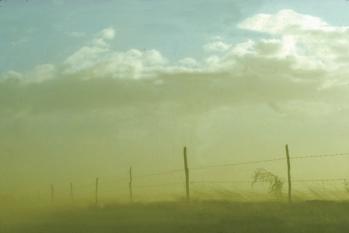
Dust storms are atmospheric disturbances with moderate to strong winds, blowing soil particles, and visibility reduced to one kilometre or less at eye level. Dust storms are serious climatic hazards for Saskatchewan, resulting in environmental, health and economic costs. These include soil erosion, vegetation damage, respiratory problems, and fatalities. The semi-arid to sub-humid climate, topography, vegetation, soil conditions and land use in agricultural Saskatchewan provide an ideal setting for dust storms. Dust storms begin after a period of dry weather, when the wind speed is greater than the threshold value needed to lift and transport vulnerable soil particles, or when moving particles bombard an area. Land management practices such as cultivation and over-grazing increase dust storm risk because they loosen soil particles and reduce the protective vegetation cover.
Spring, especially April, is the time of peak dust storm occurrence. A weak secondary peak may occur during August. This spring maximum likely results from the combination of peak wind speed and lack of vegetative cover. Canada's dust storm bowl is located in south-central Saskatchewan. This area has the second highest annual dust storm frequency in North America. An improved understanding of the nature of the dust storm hazard is crucial to improving the sustainability of the prairie ecosystem.
E.E. Wheaton